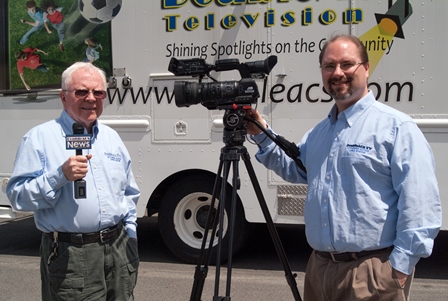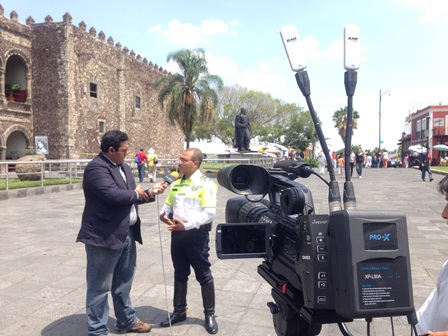'Go Anywhere' ENG
SEATTLE—When Tim Dietz began his career as a news photographer shooting 16 mm film, getting footage just shot into the station’s newscast involved a pedal to the metal drive back to the station and at least a half hour to process the film. He said that back then, the idea of going live with cellular liveshot systems was “a distant thought.”
Since then, Dietz, now vice president of KUSA Interactive in Denver has had a change of heart. “They really allow people to do what a lot of us got into the business to begin with, to take people where they can’t normally go.”
In addition to using the station’s TVUNetworks cellular liveshot gear to cover breaking news live, reporter/photographer Matt Renoux pairs that liveshot gear with a GoPro camera to provide live inserts into the station’s newscasts from challenging circumstances such as zip-lining in Colorado’s mountains.
Last winter, and halfway around the world, Dietz and news teams from a number of Gannet’s NBC affiliates took five TVU Networks’ cellular liveshot units to Sochi to provide live coverage tailored to the local stations.
He said that because host country Russia had built out a lot of cellular capacity, at the Olympic Village and mountain venues, “a bonded cellular solution like TVUNetworks allows some untethering and the freedom to do liveshots that you would normally not have been able to do with the limitations of the Olympic city’s wired infrastructure.”
CLOSER TO THE ACTION

KTBS-TV, the ABC affiliate in Shreveport, La., prefers the suitcase design of the Dejero 20/20 cellular transmitter.
The professional video industry's #1 source for news, trends and product and tech information. Sign up below.
Karen LaFleur, director of news operations for KPRC-TV, the NBC affiliate in Houston, said one of the appeals to the LiveU and Dejero cellular liveshot units they put in the field is those units’ multiple cellular modem card capacity. “We’ve found that we’ve been able to get better quality with six-card units,” she said. LaFleur added that they’re able to drive news cars at freeway speeds without losing their connection, noting how important it is to be able to mix and match modems for cellular networks, so crews can pick the one that works the best at each location.
LaFleur commented on how a recent breaking news event pointed to an advantage of cellular liveshot gear over microwave or satellite trucks: their relative unobtrusiveness. The story involved police finding a house with about 100 illegal immigrants living in it, according to LaFleur.
“When stations pulled up their big trucks, they all got held behind a perimeter, she said. “But we arrived on scene earlier, and with our LiveU gear we could send back live shots that were closer and of better quality.”
LaFleur doesn’t see the cellular gear signaling the death knell of microwave and satellite trucks. Microwave and satellite equipment “give you a solid signal and you’re not going to get interference, like at a stadium with tons of people making calls and sending pictures.” She also noted that the larger trucks provide journalists a more comfortable workspace.
A REAL ‘GAMECHANGER’
Shreveport’s KTBS-TV chief engineer Dale Cassidy said that when the ABC affiliate evaluated cellular liveshot gear, in addition to the equipment’s technical capabilities, form factor was also a major consideration. They looked at backpacks, “but we have a lot of field reporters who are younger and petite, and you can’t start strapping a backpack onto them along with everything else they need to carry.” That led them to favor a suitcase design from Dejero.
“It’s been a real gamechanger for us,” he said. “We dedicated one of the units to our Texarkana [Ark./Texas] bureau, 70 miles away.” At the most recent Mardi Gras parade in Shreveport, the station turned the tables on its parade coverage by shooting from a float instead of from the street. “We had one of the Dejero suitcase units right on the float with us, sending our live video and audio back to the studio.”
As with any other new piece of equipment, there was a learning curve, according to Cassidy. “If you found yourself in an area where you didn’t have sufficient bandwidth for a good HD signal, you just dropped down to SD to get the signal back to the station.” And he said that just like with any cellular phone, there are holes in the cellular network’s coverage that have to be worked around.

Attleboro Access Cable System Operations Manager Jim Jones (R), shoots with JVC's GY-HM650 camcorder, which features built-in cellular liveshot capability.
When operations manager Jim Jones and his team at the Attleboro [Mass.] Access Cable System looked at JVC’s GY-HM650 camcorders, with built-in cellular liveshot capability, they liked the concept that there was not an additional piece of gear necessary to send audio and video back to their studio. “We said OK, this is really the way we believe the market is going,” Jones said.
Their city’s location is about halfway between Boston and Providence. That has meant that “unless there’s a murder or huge fire, you don’t see anything about our community on stations in those markets.” The JVC gear lets them travel to local communities cover local events live, and to share that coverage with other public access operations in the region.
He emphasized the importance of being able to dial down the bitrate when cellular networks get busy. During a Fourth of July fireworks coverage, “with 10,000 people standing around you, you can’t do a 3 Mbps connection, even on 4G,” Jones said. “But we were able to dial it down to 1.5 Mbps and transmit it back to the station without any issue. There was no stutter, no lag, no delay. We could have even dialed it down to 0.8 Mbps if we’d had to.”
A year ago Mexico’s Stereo Mundo de Morales needed to upgrade its remote broadcast operations to support two daily newscasts covering local government and breaking news. Chief engineer Martin Morales said they chose to go with an IP solution instead of satellite, and looked at three main criteria in selecting cellular liveshot gear: portability, low latency (delay), and flexibility.
He said they began by making “an exhaustive and conscientious search among the available IP codecs in the market.” That led them the Comrex Liveshot, which combined capability with simplicity.

Mexican station Stereo Mudo de Morales has deployed the Comrex Liveshot to shoot remote video from the field.
“With Liveshot we have the capability to carry this small unit on a motorcycle and send live audio/video while in motion,” Morales said. “When a green CrossLock indictor indicates a path is established back to the studio, with one button push we are sending our live material within just a few seconds.”
Morales credits Comrex’s tight codec with minimizing delay in liveshots. “Under the best circumstances while using a 3G connection, we have only about one second of delay with good image quality.” He also described the challenging topography of Cuernavaca the capital city of the state of Morales, where his news crews sometimes need to reduce the bitrate to hold a liveshot together. “LiveShot gives us the opportunity to select, with one button, the quality of video to send, depending on the conditions of bandwidth, without complex configurations,” he said.
As cellular network providers continue to build out their high-bandwidth infrastructures, cellular liveshot units can be expected to become more and more popular. If the other guys in the market have them, your station has to buy some just to keep up.
